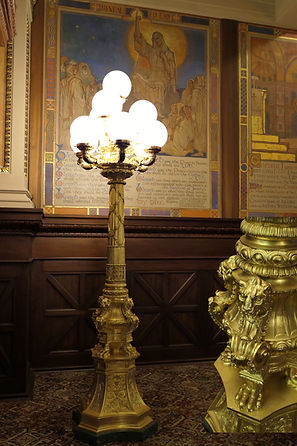
Harrisburg
The First Two Capitols in Harrisburg

Three Capitol Buildings have housed the state government in its capital, Harrisburg. The first, designed by Stephen Hills, was dedicated in 1822 functioned until it was destroyed by a fire on February 2, 1897. Source: Presented to the Supreme Court of Pennsylvania by the Pennsylvania Bar Association on May 22, 1972 at Independence Hall, Philadelphia Pa. On the 250th Anniversary of the Founding of the Supreme Court of Pennsylvania. Artist Unkown.

While conducting its business in the Grace Methodist Church, the legislature provided funding for the building of the Cobb Capitol, designed by Henry Ives Cobb. However, that funding was insufficient and the facade and foundation were integrated into the third Capitol Building. Source: Capitol Preservation Committee. Photographer Unknown.
The Huston Capitol


The third Capitol in Harrisburg, was designed by Joseph Huston and building began in 1902. President Theodore Roosevelt attended the dedication in 1906, declaring the building "the handsomest State Capitol I have ever seen."
The distinctive green, terra cotta tiled dome weighs 52 million pounds and is 1/3 scale version of the dome over St. Peter’s Basilica in Rome. The four main government chambers as well as the rotunda all take inspiration from various European architectural styles.
The Hallway


Huston intentionally put the courtroom on the fourth floor to physically, and symbolically, separate the judiciary for the dealings of the legislative and executive chambers on the second floor.


The hallway leading to the courtroom showcases the hand stenciled and painted artistic elements as well as the bronze "pumpkin" lights with cut-crystal shades.
The Courtroom




Bottom: (L) The courtroom as it appeared in 1972. (R) The courtroom today.
While opened for arguments in 1906, the courtroom was the last chamber in the Capitol Building to be finished in May 1927, with the installation of the Oakley murals.
The Furnishings


All of the furnishings in the courtroom are original to the building with the exception of the seven chairs at the bench. However, one of the originals was donated to the Court by Representative Brett Miller's family and reupholstered by the Capitol Preservation Committee.


Each of the doorknobs in the Court's space is cast in bronze with the state seal. One of nearly 300 original Capitol clocks adorns the rear wall of the courtroom with the state's coat of arms decorating the clock face, designed by Huston.
The Lighting


Four 1 1/2 ton, 24-karat gilded bronze light standards furnish light to the four corners of the court. Four 2 ton, ungilded chandeliers hang from the ceiling.




While the chandeliers may appear identical, each has a unique statue under the main light dedicated to four great law givers. Aristotle and Solon (top l to r) and Moses and Solomon (bottom l to r).

The only stained glass dome in the Capitol complex. Created by Alfred Godwin, this dome was originally to be placed over the House chamber, but was moved to the courtroom after another floor of offices was added above the House. While much of the light in the courtroom is artificial, with the right conditions the sun bathes the courtroom in a beautiful blue-green light.
Interested in visiting the Capitol Building?
Contact the Capitol Tour Guides.
Note: The courtroom is used for official and ceremonial events throughout the year and may not be available during your tour.
Can't visit in person?
Take a virtual tour of the courtroom.


